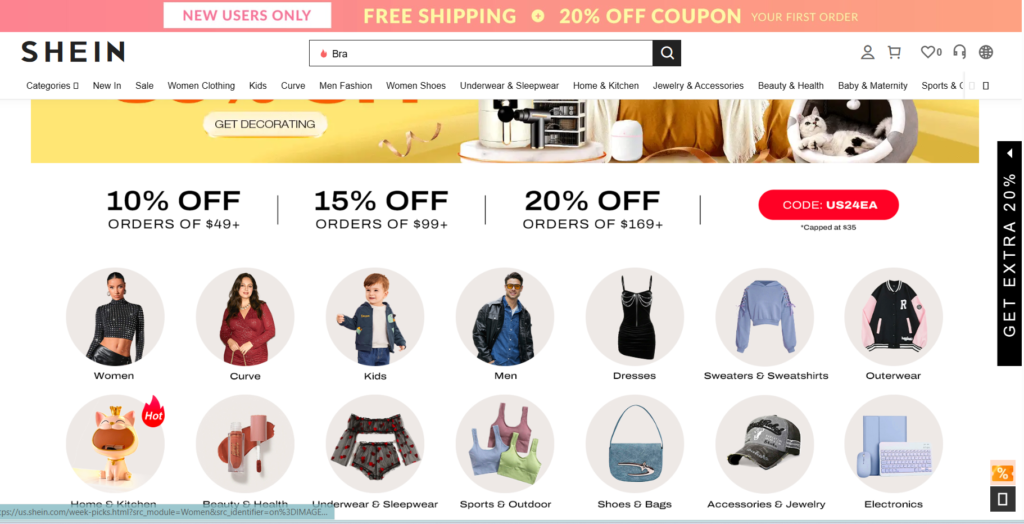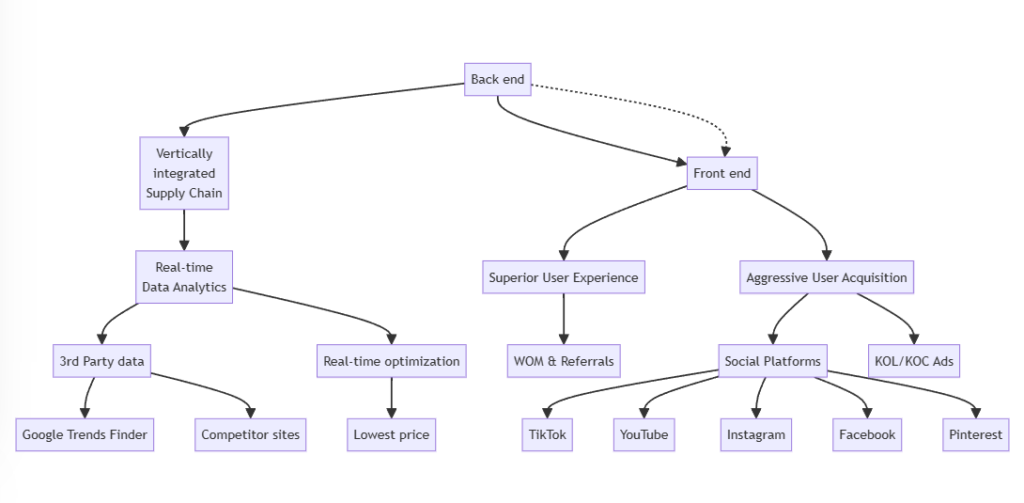In just over a decade, SHEIN has ascended from a little-known Chinese online retailer to the dominant global leader in fast fashion e-commerce. The brand epitomizes the quick, trend-driven fashion favored by youth today. So how did SHEIN disrupt the fashion industry to become a $100 billion juggernaut?
Agile and Digitized Supply Chain
SHEIN’s supply chain is the engine behind its ability to design and deliver hyper-current styles faster than anyone else. The “small order, quick return” model powered by big data analytics allows SHEIN to launch and iterate products in as little as 21 days. Their headquarters in Southern China facilitates close coordination with thousands of small contract manufacturers to execute agile production. Advanced AI and demand sensing gives SHEIN real-time visibility to optimize inventory and fulfillment across a network of logistics hubs. This digitally-driven supply chain is a core competitive advantage.
The data middle platform collects information for coordinated production planning. SHEIN’s suppliers form a huge information network through the supply chain management system. By collecting real-time information from the front end, the data middle platform analyzes and plans reasonable production solutions and then places orders with suppliers. The supply chain system can also visualize the production process for real-time monitoring and timely adjustment. When problems occur in a certain batch of goods, the middle platform can quickly make up orders from other manufacturers with available production windows to ensure on-time delivery. SHEIN’s data middle platform is comprehensive, efficient and flexible, connecting all members of the supply chain into an organic whole.
Digital management makes the production cycle visible. The middle platform is able to collect data so accurately because SHEIN’s self-built supply chain management system already covers suppliers’ design, plate-making, raw material procurement, production, quality control, inventory management, shipping and all other processes. This digital empowerment of small factories solves the problems of low inventory accuracy and unstable production capacity for small factories, visualizes each order’s processes, smoothens the entire supply chain circulation path, and improves circulation efficiency. SHEIN continues to research and develop patents in the supply chain field, consolidating its technological barriers in digitization and continuously building an irreplicable supply chain model.

Source: https://www.sheingroup.com/
- Headquarters Relocation Enables “Small Order Quick Return”
SHEIN moved its headquarters from Nanjing to Panyu, Guangzhou, and built a supply chain headquarters there. Panyu, Guangzhou gathers a large number of small and medium-sized apparel manufacturers, with natural geographical advantages from fabric sourcing to processing and production. Among SHEIN’s core cooperating suppliers, around 300-400 are located close to the company headquarters. Under the “small order, quick return” model, SHEIN tends to choose small suppliers who can accept small batch orders, and digitally empower them through its self-built supply chain system, helping these small companies improve management and production efficiency, gain the ability to collaborate, and become part of SHEIN’s flexible supply chain.
Three Supplier Partnership Models Are Complementary
SHEIN has three main partnership models with suppliers: FOB (made-to-order production), ODM (original design manufacturing), and MOTF (high-end series): 1) In the FOB model, SHEIN provides designs and samples, and suppliers make-to-order and produce. This model relies on SHEIN’s large number of buyers and designers to conduct trend analysis on data, create hit designs, and then produce in small batches through small manufacturers, giving full play to the strengths of both SHEIN and suppliers. 2) The ODM model requires suppliers to independently design, and SHEIN reviews and approves. This model places higher demands on suppliers’ development and design capabilities. By opening up more design rights to suppliers, it helps explore different product styles. 3) MOTF is a high-end independent brand under SHEIN, which began seeking supplier partnerships after launch. MOTF is SHEIN’s main focus for high-end branding, with corresponding supply chain upgrades and stricter requirements for suppliers.

SHEIN’s Main Partnership Models With Suppliers
Building an Independent Website to Attract Traffic
Strategic foresight: Build an independent platform free of third-party restrictions. There are two e-commerce models – joining third-party platforms for sales, or using an independent website. Independent websites sell through independent domains and software, allowing brands to build awareness, retain data, avoid platform fees, and free themselves of third-party platform constraints. In 2021, the number of Chinese cross-border e-commerce independent websites reached around 200,000. According to research institute iiMedia, independent websites’ market share is expected to rise from 25% in 2020 to close to 50% in 2025. SHEIN chose the independent website model from the outset rather than leveraging established overseas e-commerce platforms. This demonstrated SHEIN’s ambition and explained its stellar results. Looking at successful internet companies like Google, Baidu, Facebook, all own independent user entry points. Independent websites not only have stable private domain traffic, but can also evolve into tool platforms with value far beyond a single brand.

SHEIN US Shopping Website
SEO Solidifies Organic Traffic, Multiple Channels Drive Traffic Inflow

SEO expertise helped SHEIN smoothly accumulate initial users. For independent sites, SEO to improve search engine rankings and organic traffic volume is essential for marketing. In the early stages, founder Chris Xu leveraged years of overseas SEO experience to accumulate fixed traffic and original users through search engine marketing (SEM), ranking for keywords and optimizing tags.
With steady traffic, SHEIN adopted diverse methods to continue harvesting traffic from other platforms. SHEIN’s traffic marketing drove efficient inflow – direct visits account for a high percentage and repurchase rate is high. As of Sept 2022, 7.61% of SHEIN’s website traffic comes from social media, 46.22% from search, and 37.57% from direct.
- SHEIN’s traffic driving tactics:
Leverage influencer content creators. SHEIN quickly partnered with influencers and KOLs. As early as 2010 (before influencer marketing took off), SHEIN strategically focused on social media, especially influencers and celebrities with selling power. SHEIN works with influencers of all follower sizes – micro (hundreds to thousands), KOC (tens of thousands to hundreds of thousands), KOL (millions), and celebs (tens of millions+) are all targets. SHEIN successfully harvested YouTube, Facebook and TikTok influencers via commissions, free products, exclusive discounts and paid partnerships. Currently SHEIN content dominates YouTube (600+ million unboxing views) and TikTok (200+ billion views).
Participate in affiliate marketing campaigns. Affiliate marketing is a popular tactic overseas where users register as an affiliate then promote products on social media in exchange for sales commission rewards. SHEIN offers high commissions up to 10-20% of sales, plus cash bonuses. Its affiliate program further expanded SHEIN’s marketing reach.
Manufacture trending topics to harvest social buzz. By creating buzzy topics, SHEIN attracted social media users who then became brand fans.
Differentiation: Win-Win Collaborations, Long-Term Vision
Expanding differentiated products deepens brand labels. As SHEIN’s hit products are designed based on current trend elements, they have homogeneity and may clash with existing market apparel, making it difficult to shape brand image. To deepen competitive differentiation, in 2021, SHEIN launched “SHEIN X” – collaborations with independent fashion designers and illustrators, building long-term partnerships. In these collaborations, SHEIN handles manufacturing, marketing, product operations while designers just focus on design, sharing profits and retaining creative ownership. As of now, SHEIN has collaborated with over 1,500 designers and artists from 20+ countries through SHEIN X. In 2022, collaborating designers/artists are projected to reach 3,000. In August 2022, SHEIN’s “SHEIN X 100K Challenge” mobilized 100,000 designers to participate, gaining exposure for more designers. Through SHEIN X alone, the company launches over 30 new items every month. In 2021, products designed by Freak City LA founder Valerie Campbell for SHEIN sold 11,505 pieces, becoming one of the best-sellers. Moving forward, SHEIN hopes to establish a unique brand image and elevate brand reputation through these collaborations.
Global Execution and Localization
SHEIN is leveraging China’s expertise in cross-border e-commerce, manufacturing and digital supply chains. The brand has now expanded to serve over 150 countries globally. As it scales, SHEIN is localizing elements of its supply chain, logistics and operations overseas. Localized warehouse networks and customer service centers provide better delivery and support. SHEIN’s global reach, local execution and understanding of youth culture worldwide fuel its leadership across continents.
